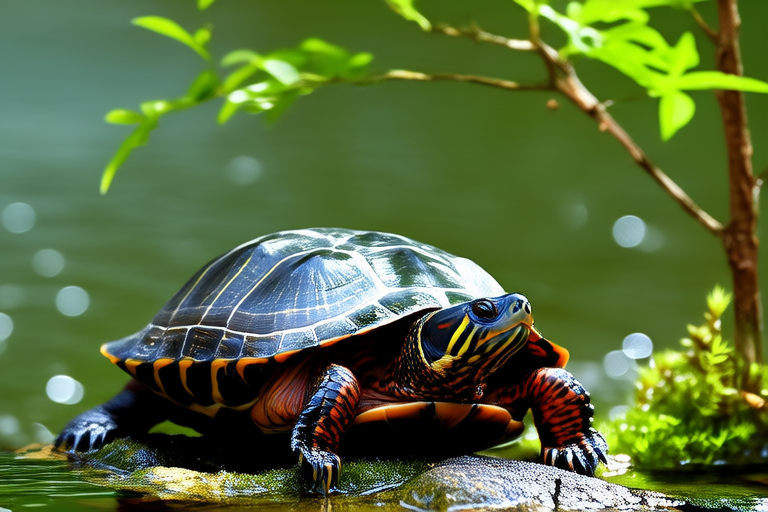Top 10 Fascinating Facts About Red-Eared Sliders You Need to Know
Red-eared sliders, scientifically known as Trachemys scripta elegans, are one of the most popular pet turtles in the world. These semi-aquatic turtles are not only fascinating to observe but also offer valuable insights into turtle biology and behavior. Whether you’re a seasoned herpetologist or simply curious about these captivating creatures, here are ten facts that will deepen your appreciation for red-eared sliders.
1. The Name ‘Red-Eared Slider’ Has a Unique Origin
The term “red-eared slider” comes from the distinctive red markings behind their eyes, which resemble ear lobes. These marks are actually part of their facial pattern and serve as a form of camouflage. The word “slider” refers to their ability to slide off rocks or logs into water quickly when threatened. An image of a red-eared slider showing its red marking would be helpful here, emphasizing the contrast against its greenish-brown shell.
2. They Are Native to North America
Red-eared sliders originally inhabit the Mississippi River Valley and Gulf Coast regions of the United States. They thrive in freshwater environments such as ponds, lakes, and slow-moving rivers. Their natural habitat provides them with ample space for basking and hunting for food like insects, small fish, and aquatic plants. A map highlighting this region could illustrate their native range effectively.
3. Red-Eared Sliders Can Live Up to 40 Years
With proper care, red-eared sliders can live for several decades, making them a long-term commitment for any owner. Their longevity is attributed to their robust immune system and slow metabolic rate. However, it’s crucial to understand the responsibilities involved in keeping these pets for such extended periods. A photo of an elderly red-eared slider would help convey the idea of longevity.
4. They Are Cold-Blooded Reptiles
Red-eared sliders are ectothermic, meaning they rely on external sources of heat to regulate their body temperature. This characteristic explains why they spend considerable time basking in the sun. Basking helps them maintain optimal internal temperatures for digestion and other bodily functions. An illustration depicting a slider basking on a rock near water would enhance this point visually.
5. Mating Rituals Are Complex and Intriguing
During mating season, male red-eared sliders perform elaborate courtship dances to attract females. They may swim around the female, tap her head or forelegs, and even bite gently. If successful, the female will lay eggs in a sandy area away from water. A video clip or animated sequence of mating rituals would make this fact more engaging for readers.
6. They Have Remarkable Camouflage Abilities
Red-eared sliders possess excellent camouflage skills due to their coloration and patterns. Their greenish-brown shells and skin blend seamlessly with aquatic vegetation, helping them avoid predators like raccoons and birds. This adaptation is particularly useful during their vulnerable hatchling stage. An image showcasing a young slider among aquatic plants would highlight this survival strategy.
7. Habitat Destruction Poses Significant Threats
Despite their widespread popularity as pets, wild populations face challenges due to habitat destruction caused by urbanization and pollution. Conservation efforts aim to protect remaining habitats and promote sustainable practices. A photograph of a polluted riverbank juxtaposed with a clean one would underscore the importance of conservation.
8. They Can Hibernate Underwater
In colder climates, red-eared sliders enter a state called brumation, similar to hibernation. During brumation, they become less active and may remain submerged at the bottom of bodies of water for months. Their metabolism slows down significantly, allowing them to survive without eating. A diagram showing the physiological changes during brumation would aid comprehension.
9. Captive-Bred Red-Eared Sliders Make Ideal Pets
Captive-bred red-eared sliders are generally healthier and better adapted to life in captivity compared to wild-caught ones. They tend to be more docile and easier to handle. For potential owners, purchasing from reputable breeders ensures ethical sourcing and healthier pets. An image of a captive-bred slider interacting with its owner would demonstrate the bond between humans and these turtles.
10. They Exhibit Fascinating Social Behaviors
Red-eared sliders are social animals that enjoy being around others of their kind. In groups, they establish hierarchies based on size and strength. Dominant individuals often have priority access to basking spots and feeding areas. Observing these interactions can provide hours of entertainment for owners and researchers alike. A video clip capturing social interactions within a group would enrich this aspect of their behavior.
Responsible Pet Care Tips for Red-Eared Sliders
If you’re considering adopting a red-eared slider, remember that providing appropriate living conditions is essential. Here are some tips:
- Proper Housing: Ensure your turtle has enough space with both land and water areas. The tank should be large enough to allow swimming and basking.
- Diet: Feed them a balanced diet consisting of commercial turtle pellets, fresh vegetables, and occasional treats like mealworms.
- Water Quality: Maintain clean water by regularly changing it and using filtration systems if necessary.
- Basking Area: Provide a heated basking spot with UVB lighting to mimic sunlight.
- Health Monitoring: Regularly check for signs of illness such as swollen eyes, lethargy, or loss of appetite.
By following these guidelines, you can ensure a happy and healthy environment for your red-eared slider. Remember, owning a pet turtle requires dedication and commitment over many years.
